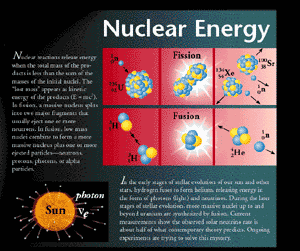Nuclear Energy


Fission
Fission occurs when the nucleus of an atom divides into two smaller nuclei. Fission can occur spontaneously; it may also be induced by the capture of a neutron. For example, an excited state of uranium (created by neutron capture) can split into smaller "daughter" nuclei. Fission products will often emit neutrons because the N/Z ratio is greater at higher Z. With a proper arrangement of uranium atoms, it is possible to have the neutrons resulting from the first fission event be captured and to cause more uranium nuclei to fission. This "chain reaction" process causes the number of uranium atoms that fission to increase exponentially. When the uranium nucleus fissions, it releases a considerable amount of energy. This process is carried on in a controlled manner in a nuclear reactor, where control rods capture excess neutrons, preventing them from being captured by other uranium nuclei to induce yet another uranium fission. Nuclear reactors are designed so that the release of energy is slow and can be used for practical generation of energy. In an atomic bomb, the chain reaction is explosively rapid.
Fusion
Fusion occurs when two nuclei combine together to form a larger nucleus. Fusion of low-Z nuclei can release a considerable amount of energy. This is the Sun’s energy source. Four hydrogen nuclei (protons) combine in a multistep process to form a helium nucleus. More complicated fusion processes are possible; these involve more massive nuclei. Since the energy required to overcome the mutual electric repulsion of the two nuclei is enormous, fusion occurs only under extreme conditions, such as are found in the cores of stars and nuclear particle accelerators. To fuse higher-Z nuclei together requires even more extreme conditions, such as those generated in novae and supernovae. The stars are ultimately the source of all the elements in the periodic table with Z greater than or equal to 6 (carbon). Because fusion requires extreme conditions, producing this nuclear reaction on Earth is a difficult technical problem. It is used in thermonuclear weapons, where the fusion reaction proceeds unchecked. Controlled fusion with release of energy has occurred, but no commercially viable method to generate electrical power has yet been constructed.
|

